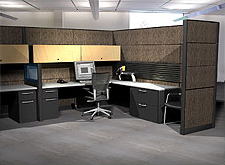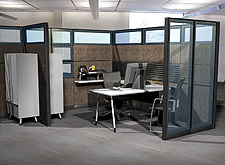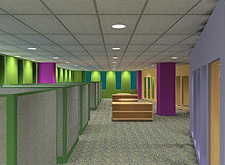Introduction
Within This Page
Interior design concerns itself with more than just the visual or ambient enhancement of an interior space; it seeks to optimize and harmonize the uses to which the built environment will be put. Thus, in the words of the U.S. Bureau of Labor Statistics, it is "practical, aesthetic, and conducive to intended purposes, such as raising productivity, selling merchandise, or improving life style." Interior design is a practice that responds to changes in the economy, organization, technology, demographics, and business goals of an organization.
As a human activity, interior design is centuries old. As a coherent profession identified by the label "interior designer," it is relatively recent. Many experts trace its beginnings to the early 20th century and the rise of interior decoration as a career separate from architecture. In the early decades, this practice focused largely on the residential arena. By the 1940s, the terms "interior design" and "interior designer" were used primarily by those individuals providing services to a small but growing number of business clients. After World War II, nonresidential design—offices, hotels, retail establishments, and schools—grew in importance as the country rebounded economically. Interior design is generally divided into two categories, residential and contract or commercial. Today, interior design is becoming increasingly specialized as buildings and materials get more complex technologically and regulations and standards more demanding.
The first national professional organization for interior designers, The American Institute of Interior Decorators (later, the American Institute of Interior Designers), was founded in 1931, and a second, the National Society of Interior Designers, in 1957. But it was not until the 1960s and 70s that independent organizations were established to assess qualifications for designers and design programs, thereby putting in place the cornerstones of the profession; standards for education, experience, and examination. These are the Interior Design Educators Council, the Foundation for Interior Design Education Research, and the National Council for Interior Design Qualification. In 1975, AID and NSID merged to form the American Society of Interior Designers. The International Interior Design Association was founded in 1994.
Efforts to bring about statutory licensing of interior designers, variously through title or practice acts, also began in the 1960s. In 1982, Alabama became the first state to enact legislation for the regulation of interior design. Today, 25 states and jurisdictions have adopted some form of regulation for interior design. A current list of interior design laws by state can be found on the ASID website.
Description
A. Professional Definition
Interior design is a multi-faceted profession in which creative and technical solutions are applied within a structure to achieve a built interior environment that solves the customer's problems and links space to business strategies and goals. These solutions are functional, enhance the quality of life and culture of the occupants, and are aesthetically attractive. Designs are created in response to and coordinated with the building shell, and acknowledge the physical location and social context of the project. Designs must adhere to code and regulatory requirements, and encourage the principles of environmental sustainability. Interior design can also influence the choice of real estate that will address the organization's needs through the architecture and design elements. The interior design process follows a systematic and coordinated methodology, including research, analysis, and integration of knowledge into the creative process, whereby the needs and resources of the client are satisfied to produce an interior space that fulfills the project goals.
Interior design includes a scope of services performed by a professional design practitioner, qualified by means of education, experience and examination, to protect and enhance the life, health, safety, and welfare of the public. For the full definition, consult the National Council for Interior Design Qualification.
B. Professional Role in the "Whole Building" Design Process
The interior design professional is extremely important in the "whole building" design process and should be contracted at the onset of the project, referred to as the pre-design phase or programming phase, with the other major disciplines, key stakeholders, client, and end-user contacts. The interior designer needs to work closely with the client to understand their business and space needs. This can be thought of as strategic programming. It should occur at the same time as the building program is conducted. By assisting the organization in understanding its needs, as well as analyzing and recommending ways to link the organization's mission, business, and work processes to an intelligent workplace and space strategy, the interior designer adds value to the client's organization and real estate. Excellent communication with the key members of the team helps define the challenges and each team member's expectations to ensure a successful project. The interior designer must communicate the intent or project plan and what "whole building" systems and architecture can be explored to meet client expectations. Thus, an integrated team approach is important, and the coordination and collaboration of all disciplines is essential to a successful solution.
C. Professional Strategies for Achieving Relevant Design Objectives
It really takes a team to get smarter solutions. Organize the team at the onset of the project. Include the building manager and most importantly a qualified design team with key disciplines and construction manager at the onset. The interior designer should no longer receive a plan from the architect to perform space planning, materials, and furniture selection. The basic principles of a workplace can address and include the following criteria and thus the need for all disciplines to work as a team. These are U.S. General Service Administration (GSA) principles or "hallmarks" for their workplace. (Figs. 1-3)

Fig. 1: A typical workstation layout involves corner orientation. Photo Credit: Haworth, from Better Lighting and Daylighting Solutions (2005, American Society of Interior Designers)
- Healthy: Create a clean, environmentally sustainable workspace with good acoustics, lighting, and air quality.
- Security and Safety: Create the workplace in such a way that physically protects the occupants and assets from man-made and natural hazards.
- Comfort: Distribute workplace services, systems, and components that allow occupants to adjust thermal, lighting, acoustics, and furniture systems to meet personal and group comfort levels.
- Reliability: Support the workplace with efficient, state-of-the-art heating, ventilating, air-conditioning (HVAC) systems, and equipment that require little maintenance, minimal loss of service, and less energy.
- Flexibility to address the client's goals are varied and can include:
- Under floor access to all workspace services
- Maximum user control of the work environment
- Mobile furniture and technology
- Building utilities that are everywhere, reconfigurable, and expandable
- Alternate work places, hoteling, teleworking, etc.
- Diverse work settings for diverse work and workforce
- Brand or Image: The work environment is one medium of communicating an organization's principles to internal and external customers. Branding creates a sense of pride and commitment to the organization and its stakeholders.
- Equity Fairness: The workspace is designed for function and provides all users with daylight, privacy, outside views, and personalized workspace in an aesthetically pleasing manner.
- Technological Connectivity: Enables full communication and simultaneous access to data among and distributed to coworkers both on and off-site including teleworking, hoteling, etc., and has built-in capacity and flexibility to adapt to future technologies.
D. Relationship of Interior Design to Involved Building Systems

Fig. 2: A more advantageous workstation layout includes office orientation and glazing. Photo Credit: Haworth, from Better Lighting and Daylighting Solutions (2005, American Society of Interior Designers)

Fig. 3: Design and lighting combine to create the visual environment as occupants perceive it. Photo Credit: Haworth, from Better Lighting and Daylighting Solutions (2005, American Society of Interior Designers)
The interior designer must not only be knowledgeable (though not an expert) in building systems, but also at times recommend a system concept that supports the goals of the client and the design direction. For example;
- Flexibility may be a key driver for the space. The interior designer may request that the engineers consider an under floor air distribution system with a raised floor solution to solve this problem. This impacts the architecture, electric, and data distribution.
- Lighting and equitable fairness may also be a driver. The interior designer in developing a scope of work for a lighting consultant must be aware of the coordination of daylight/views with electrical ambient light and individual task lights. This can impact the electrical engineer's work. In new construction, the interior designer may request that the window design accommodate equitable light distribution to all associates in the workplace.
It is important that the interior designer is included in these decisions and is given or develops with other disciplines the cost analysis and life-cycle costing to make the best design decision for the client. It is important to analyze building systems from a holistic viewpoint and specify environmentally sustainable materials and methods.
E. The Effects of Whole Building on the Interior Design Profession are Very Positive
- Requires recognition by the building industry that the interior design profession is critical in workplace problem solving.
- Creates more career opportunities for interior designers utilizing creative and business skills.
- Requires continuous education for the designer--both formal and informal.
- Requires awareness of the factors that exist that impact customer's organization: the global view, the business arena, demographics, technology, economics, changing nature of work, competition, etc.
- Creates need for interior design professionals to be knowledgeable in sustainable design and LEED accredited.
- Requires excellent communication skills to coordinate, collaborate, and guide the client, and contribute to the team's solutions. In some cases, the senior designer leads the effort.
Thus, an experienced designer has career opportunities as a strategic consultant, change agent, environmental expert, communication consultant, project manager, workplace researcher, writer, speaker, and brand consultant; in addition to doing the creative space planning and specifying finishes, materials, furniture, etc.
The benefits to the client can be enormous. The costs of projects can be reduced when all members are working from the beginning and coordinating information. Schedules can be tightened. This brings value to the client and accolades to the team.
Emerging Issues
Change is a given in the dynamic business arena, and interior design professionals must help clients adapt to change. Thus, the designer needs to be knowledgeable of the customer's business needs, competition, and values.
- Recent developments and research indicate a strong correlation between the quality of workplace design and worker productivity.
- Private sector corporations are using workplace design to attract and retain a talented, high performing workforce.
- Sustainable design and energy conservation is a goal for government agencies and others to reduce negative impact on the natural environment by the built environment. Sustainability is driving design decisions more frequently.
- The cost of moving associates is reduced with flexible work environments. It requires less work downtime, and reduces first cost.
- The consideration of life-cycle costing versus first-time costs can enhance user satisfaction, and reduce costs over the long term while providing a more productive work environment.
- Balancing the demographics of the workspace is challenging. Preparing for the departure of the baby boomers is daunting. Addressing the motivations and work habits of the new generation is critical. There are a minimum of four generations in the workforce with diverse motivations and drivers.
- Image and branding workspace expresses the principles of an organization and creates opportunities of dedication and connectivity of its associates. This is also a tool to attract and retain talent (e.g., cities are positioning to attract young professionals in order to revive the local brain trusts and economies).
- Population growth and education levels are rising faster in emerging economies than in established ones, thus shifting labor pools.
- Ease of mobility and other demographic forces are creating new worker demands for quality of life improvements that intelligent employers can leverage to attract and retain high performing employees. Telework, hoteling, and diverse work settings are now considered.
- Flattening the levels of an organization increases communication speed.
- Increased market competition is amplifying the need for and advantages of differentiation, innovation, and strategic direction. The workplace properly designed can increase and reward strategic and innovative ideas.
Ongoing issues will continue to impact the interior designer's performance and way of doing business.
- Technology will continue to impact the complexity and individualization of interior design education for both faculty and students.
- Every student will own a laptop computer and have advanced computer capabilities. Instructional delivery systems (e.g., Blackboard) will continue to expand the use of electronic research, multi-media presentations, and distance education.
- Design processes will integrate high-tech solutions and presentations for design projects and include virtual imaging and experiential spaces.
- Ongoing technological improvements will force education to partner with the professional community in cost sharing of high-tech equipment, software, and resources.
Relevant Codes and Standards
Professional Registration
Interior designers are regulated by title or licensed to practice in 25 U.S. states and jurisdictions: Alabama, Arkansas, California, Colorado, Connecticut, Florida, Georgia, Illinois, Iowa, Kentucky, Louisiana, Maine, Maryland, Minnesota, Missouri, Nevada, New Jersey, New Mexico, New York, Puerto Rico, Tennessee, Texas, Virginia, Washington, DC, and Wisconsin. State regulations set qualifying standards of education, experience, and examination for the practice of interior design, and for the use of a state-designated title.
Codes
Standards
- Americans with Disabilities Act Accessibility Guidelines (ADAAG)
- ICC/ANSI A-117.1 Accessible and Usable Buildings and Facilities
Additional Resources
Professional Associations
- American Society of Interior Designers
- Association of University Interior Designers
- British Interior Design Association
- Council for Interior Design Accreditation
- Interior Design Educators Council
- Interior Designers of Canada
- Interior Design Society
- International Federation of Interior Architects and Designers
- International Interior Design Association
- National Council of Interior Design Qualifications
Organizations
- Energy Design Resources
- The Illuminating Engineering Society of North America
- New Buildings Institute
- U.S. General Services Administration (GSA)
- Environment Program Overview
- GSA Sustainable Facilities Tool (SFTool)—SFTool's immersive virtual environment addresses all your sustainability planning, designing and procurement needs.
- GSA Workplace Innovation Overview
- U.S. Green Building Council (USGBC)
Publications
- Building Systems for Interior Designers by Corky Bingelli. 2002.
- The Codes Guidebook for Interiors, 3rd edition by Sharon Koomen Harmon & Katherine E. Kennon. 2005.
- The Interior Design Profession: Facts & Figures by American Society of Interior Designers 2004.
- Interior Graphic Standards by Maryrose McGowan & Kelsey Kruse. 2003.
- Interior Lighting for Designers, 4th Edition by Gary Gordon. 2003.
- Professional Practice for Interior Designers, 3rd edition by Christine Piotrowski, ASID. 2001.
Other Resources
- InformeDesign—searchable database of design and human behavior research








